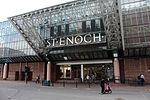St Andrew's Cathedral, Glasgow
1816 establishments in Scotland19th-century Roman Catholic church buildings in the United KingdomCategory A listed buildings in GlasgowJames Gillespie Graham buildingsListed cathedrals in Scotland ... and 6 more
Listed churches in GlasgowRoman Catholic cathedrals in ScotlandRoman Catholic churches completed in 1816Roman Catholic churches in GlasgowTourist attractions in GlasgowUse British English from December 2017

The Metropolitan Cathedral Church of Saint Andrew or Glasgow Metropolitan Cathedral is a Roman Catholic Cathedral in the city centre of Glasgow, Scotland. It is the mother church of the Roman Catholic Archdiocese of Glasgow. The cathedral, which was designed in 1814 by James Gillespie Graham in the Neo Gothic style, lies on the north bank of the River Clyde in Clyde Street. St Andrew's Cathedral is the seat of the Archbishop of Glasgow, currently William Nolan. It is dedicated to the patron saint of Scotland, Saint Andrew.
Excerpt from the Wikipedia article St Andrew's Cathedral, Glasgow (License: CC BY-SA 3.0, Authors, Images).St Andrew's Cathedral, Glasgow
Fox Street, Glasgow Gorbals
Geographical coordinates (GPS) Address External links Nearby Places Show on map
Geographical coordinates (GPS)
| Latitude | Longitude |
|---|---|
| N 55.855461 ° | E -4.252897 ° |
Address
St Andrew's Cathedral
Fox Street
G1 4AX Glasgow, Gorbals
Scotland, United Kingdom
Open on Google Maps





